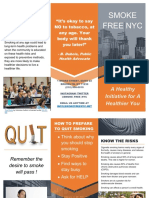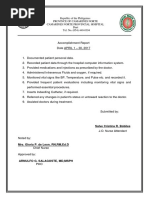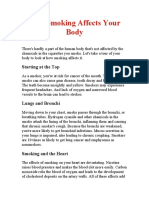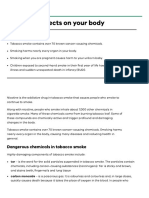The Smoker's Body
The Smoker's Body
Uploaded by
rosalumCopyright:
Available Formats
The Smoker's Body
The Smoker's Body
Uploaded by
rosalumOriginal Description:
Copyright
Available Formats
Share this document
Did you find this document useful?
Is this content inappropriate?
Copyright:
Available Formats
The Smoker's Body
The Smoker's Body
Uploaded by
rosalumCopyright:
Available Formats
Every 6.5 seconds someone dies from tobacco use, says the World Health Organization.
Research suggests that people who start smoking in their teens (as more than 70 percent do) and continue for two decades or more will die 20 to 25 years earlier than those who never light up. It is not just lung cancer or heart desease that cause serious health problems and death. Below, some of smokings less publicized side effects - from head to toe.
1. Psoriasis
Smokers seem to be more likely to develop psoriasis, a noncontagious inflammatory skin condition that leaves itchy, oozing red patches all over the body.
2
3. Wrinkling Smoking prematurely ages skin by wearing away proteins that give it elasticity, depleting
it of vitamin A and restricting blood flow. Smokers skin is dry, leathery and etched with tiny lines, especially around the lips and eyes.
6
5b
Smoking is believed to cause or worsen several eye conditions. Smokers have a 40 percent higher rate of cataracts, a clouding of the eyes lens that blocks light and may lead to blindness. Smoke causes cataracts in two ways: by irritating the eyes and by releasing chemicals into the lungs that then travel up the bloodstream to the eyes. Smoking is also associated with age-related macular degeneration, an incurable eye disease caused by the deterioration of the central portion of the retina, known as the macula. The macula is responsible for focusing central vision in the eye and controls our ability to read, drive a car, recognize faces or colours, and see objects in fine detail.
2. Cataracts
5. Cancer
More than 40 chemicals in tobacco smoke have been shown to cause cancer. Smokers are some 20 times more likely to develop lung cancer than non-smokers. Smoking causes about 90% of lung cancers in men and 80% in women 5a and according to many studies, the longer one smokes, the greater the risk of developing cancers at several sites, including a two-fold risk of developing cancer of the nasal and paranasal cavities 5b; cancer of the oral cavity 5c (4 to 5 times); two-fold risk of developing cancer of nasopharynx; oro and hypopharynx (4 to 5 times); larynx (10 times); oesophagus (2 to 5 times); stomach 5d (2); pancreas 5e (2 to 4 times) and kidney 5f. Some recent studies have also suggested a link between heavy smoking and breast cancer 5g, and smoking cessation substantially reduces the risk for most of the above-mentioned smoking related cancers.
5c
7 8
Because smoking creates plaque on blood vessel walls, decreasing blood flow to the inner ear, smokes can lose their hearing earlier than non-smokers and are more susceptible to hearing loss caused by ear infections or loud noise. Smokers are also three times more likely than non-smokers to get middle ear infections.
4. Hearing loss
6. Tooth decay
9 5a
Smoking interferes with the mouths chemistry, creating excess plaque and yellowing teeth. There is some evidence that smoking contributes to tooth decay. Smokers are one and half times more likely to lose their teeth.
7. Emphysema
In addition to lung cancer, smoking causes emphysema, a swelling and rupturing of the lungs air sacs that reduces the lungs capacity to take in oxygen and expel carbon dioxide. In extreme cases, a tracheotomy allows patients to breathe. An opening is cut in the windpipe and a ventilator to force air into the lungs (see image). Chronic bronchitis (not shown) creates a build-up of pus-filled mucus, resulting in a painful cough and breathing difficulties.
7 5g
8. Osteoporosis
5e
Carbon monoxide, the main poisonous gas in car exhaust fumes and cigarette smoke, binds to blood much more readily than oxygen, cutting the oxygen-carrying power of heavy smokers blood by as much as 15 percent. As a result, smokers bones lose density, fracture more easily and take up to 80 percent longer to heal. Smokers may also be more susceptible to back problems: one study shows that industrial workers who smoke are five times as likely to experience back pain after an injury.
One out of three deaths in the world is due to cardiovascular diseases. Smoking is one of the biggest risk factors for developing cardiovascular diseases. These diseases kill more than a million people a year in developing countries. Smoking-related cardio vascular diseases kill more than 600,000 people each year in developed countries. Smoking makes the heart beat faster, raises blood pressure and increases the risk of hypertension and clogged arteries and eventually causes heart attacks and strokes.
9. Heart disease
5d 5f
10
11 14
Smoking reduces resistance to the bacteria that cause stomach ulcers. It also impairs the stomachs ability to neutralize acid after a meal, leaving the acid to eat away the stomach lining. Smokers ulcers are harder to treat and more likely to recur.
12
10. Stomach ulcers
13
11. Discoloured fingers 13. Deformed sperm
The tar in cigarette smoke collects on the fingers and fingernails, staining them a yellowish-brown.
Besides increasing the risk of cancer of the uterine cervix, smoking can lead to fertility problems for women and complications during pregnancy and childbirth. Smoking during pregnancy increases the risk of low weight babies and future ill health consequences. Miscarriage is 2 to 3 times more common in smokers, as are stillbirths due to fetal oxygen deprivation and placental abnormalities induced by carbon monoxide and nicotine in cigarette smoke. Sudden infant death syndrome is also associated with smoking. In addition, smoking can lower estrogen levels causing premature menopause.
12. Cervical cancer and miscarriage
Smoking can deform sperm and damage its DNA, which could cause miscarriage or birth defects. Some studies have found that men who smoke have an increased risk of fathering a child who contracts cancer. Smoking also diminishes sperm count and reduces the blood flow to the penis, which can cause impotence. Infertility is more common among smokers.
Buergers disease, also known as thromboangitis obliterans, is an inflammation of the arteries, veins, and nerves in the legs, principally, leading to restricted blood flow. Left untreated, Buergers disease can lead to gangrene (death of body tissue) and amputation of the affected areas.
14. Buergers disease
14
14
This poster is an updated reproduction of The smokers body originally produced by COLORS magazine, issue 21, July-August 1997.
ACT
You might also like
- Week 15 - HEALTH AND WELLNESS PROGRAM FOR SENIOR CITIZEN PDFDocument12 pagesWeek 15 - HEALTH AND WELLNESS PROGRAM FOR SENIOR CITIZEN PDFCharlemagne Tan100% (2)
- Basic Dental PharmacologyDocument152 pagesBasic Dental PharmacologyDr-Mohamed KandeelNo ratings yet
- Advocacy BrochureDocument7 pagesAdvocacy BrochureZime Crusher88% (16)
- Form 1 - HEARS Field Report As of Jan 25 - 0Document1 pageForm 1 - HEARS Field Report As of Jan 25 - 0Roanne Lagua100% (2)
- Protaper Universal GuidelinesDocument2 pagesProtaper Universal GuidelinesliudifairNo ratings yet
- Pharmacokinetic EquationsDocument5 pagesPharmacokinetic EquationsNana BonsuNo ratings yet
- Idiophatic Thrombocytopenic Purpura (ITP) in PregnancyDocument27 pagesIdiophatic Thrombocytopenic Purpura (ITP) in PregnancyAdietya Bima PrakasaNo ratings yet
- Normal Arterial Blood Gas Values Normal Range Laboratory Test Conventional Units Si Units PH Paco Hco PaoDocument1 pageNormal Arterial Blood Gas Values Normal Range Laboratory Test Conventional Units Si Units PH Paco Hco PaoHenric CasimiroNo ratings yet
- Bayan Ko ReflectionDocument2 pagesBayan Ko ReflectionRee & Redd's Random100% (4)
- National Voluntary Blood Services Program (NVBSP) : MissionDocument4 pagesNational Voluntary Blood Services Program (NVBSP) : Missionveronica gamoso100% (1)
- A Smoker's BodyDocument1 pageA Smoker's BodyHensim Mae Cajes0% (1)
- Tobacco BrochureDocument2 pagesTobacco Brochureapi-459724684No ratings yet
- Community-Based Disaster Risk Reduction and Management (CBDRRM) Plan TemplateDocument2 pagesCommunity-Based Disaster Risk Reduction and Management (CBDRRM) Plan TemplateAlAr-JohnTienzoTimenia100% (1)
- Brochure - DRUGS Preview PDFDocument2 pagesBrochure - DRUGS Preview PDFvanessaresullar100% (2)
- What Is Illegal Fraternity? When Does Illegal Fraternity Happens?Document1 pageWhat Is Illegal Fraternity? When Does Illegal Fraternity Happens?Fiona SuzenneNo ratings yet
- Ra 9211 Tobacco Regulation ActDocument10 pagesRa 9211 Tobacco Regulation Actrocky inthesea2No ratings yet
- Accomplishment Report (JO Nurse Attendant)Document1 pageAccomplishment Report (JO Nurse Attendant)Rhys William Dionisio100% (2)
- Script For TV Broadcast 3Document4 pagesScript For TV Broadcast 3Dior DablioNo ratings yet
- Marasigan Jazrel Dale M. BROCHURE Learning Task 2 - Perf.2 MAPEH Q2 MusicDocument6 pagesMarasigan Jazrel Dale M. BROCHURE Learning Task 2 - Perf.2 MAPEH Q2 MusicJun-jun Tulin100% (1)
- The Smoker's Body: HealthDocument1 pageThe Smoker's Body: HealthPhetz SurioNo ratings yet
- The Smoker's BodyDocument1 pageThe Smoker's BodyAnna Rose CabuncalNo ratings yet
- How Smoking Affects Your BodyDocument3 pagesHow Smoking Affects Your BodySiddarth NyatiNo ratings yet
- Effects of SmokingDocument3 pagesEffects of SmokingKristine HeideeNo ratings yet
- Effect of Smoking in The BodyDocument2 pagesEffect of Smoking in The BodyNerwin Wingx Sobrevega CaroNo ratings yet
- Smoking - Health Risks: Reviewed byDocument16 pagesSmoking - Health Risks: Reviewed byNeranga Pravin SamaratungeNo ratings yet
- Exploring The Prevention of Substance Use and Abuse (Gateway Drugs: Cigarette and Alcohol)Document10 pagesExploring The Prevention of Substance Use and Abuse (Gateway Drugs: Cigarette and Alcohol)Margaux MiguelNo ratings yet
- Smoking and Cancer: Lung Cancer Male SmokerDocument2 pagesSmoking and Cancer: Lung Cancer Male SmokerAnis UmairaNo ratings yet
- How Smoking Affects Your BodyDocument2 pagesHow Smoking Affects Your BodyNeyke KusmantoNo ratings yet
- Nicotine: How Do Cigarettes Damage Health?Document5 pagesNicotine: How Do Cigarettes Damage Health?Soon MuvenNo ratings yet
- Smoking TANPA ARTIDocument2 pagesSmoking TANPA ARTIsandi jeki fatawiNo ratings yet
- Tobacco Addiction (Nicotine) : Brief DescriptionDocument13 pagesTobacco Addiction (Nicotine) : Brief DescriptionMimi HabibNo ratings yet
- Physical Effects Using TabaccoDocument6 pagesPhysical Effects Using TabaccoFilgrace EspiloyNo ratings yet
- Smoking and Your MouthDocument6 pagesSmoking and Your MouthRizki AmeliaNo ratings yet
- Health Effects of SmokingDocument2 pagesHealth Effects of SmokingSaint fourty sevenNo ratings yet
- Effects/ Biological Consequences of Smoking in Lungs and Circulatory SystemDocument5 pagesEffects/ Biological Consequences of Smoking in Lungs and Circulatory SystemRawdatul JannahNo ratings yet
- Cigarette Smoke: Tar, Nicotine and Carbon Monoxide YieldsDocument7 pagesCigarette Smoke: Tar, Nicotine and Carbon Monoxide YieldsmelinaNo ratings yet
- Smoke Is A Collection of Airborne: AstroenterologyDocument7 pagesSmoke Is A Collection of Airborne: Astroenterologymary jeanNo ratings yet
- Clearing The Air On The Hard Facts of What Smoking Does To Your BodyDocument5 pagesClearing The Air On The Hard Facts of What Smoking Does To Your BodyIlyana HaniNo ratings yet
- Bad Effects of SmokingDocument16 pagesBad Effects of SmokingMarko Papa Radman0% (1)
- 10 Reasons Smoking Is Bad For YouDocument6 pages10 Reasons Smoking Is Bad For YouYuNa YoshinoyaNo ratings yet
- Alcohol and CigarettesDocument10 pagesAlcohol and CigarettesLucky MagugwanaNo ratings yet
- Nama: Muniroh Prodi: D IV Jurusan: Analis Kesehatan SmokingDocument7 pagesNama: Muniroh Prodi: D IV Jurusan: Analis Kesehatan SmokingMunirohNo ratings yet
- 10 2 Abelhard Smoking BrochureDocument2 pages10 2 Abelhard Smoking Brochureapi-213114309No ratings yet
- Research Paper About CigarettesDocument11 pagesResearch Paper About CigarettesVeneyr UbaldoNo ratings yet
- The Health Effects of TobaccoDocument2 pagesThe Health Effects of Tobaccohotmagenta63No ratings yet
- Health Effects of Cigarette Smoking Vanessa BenningDocument4 pagesHealth Effects of Cigarette Smoking Vanessa Benningapi-489132887No ratings yet
- The Negative Effects of SmokingDocument8 pagesThe Negative Effects of SmokingTrân Moon100% (3)
- Harms of Cigarette SmokingDocument9 pagesHarms of Cigarette SmokingODIPLEXNo ratings yet
- Smoking - Effects On Your Body - Better Health ChannelDocument7 pagesSmoking - Effects On Your Body - Better Health ChannelUmair MalikNo ratings yet
- Health Risks: Smoking In-DepthDocument6 pagesHealth Risks: Smoking In-DepthsirsriNo ratings yet
- How Does Smoking Affect My Bones?Document3 pagesHow Does Smoking Affect My Bones?Kishamarie C. TabadaNo ratings yet
- English TestDocument11 pagesEnglish Testyashun491No ratings yet
- Smoking - The Facts: The Good News IsDocument5 pagesSmoking - The Facts: The Good News IsAnonymous bYHQo3gAn6No ratings yet
- Biology Health Effect of Tobacco: Made By: Anas A.H Class: IX-BDocument14 pagesBiology Health Effect of Tobacco: Made By: Anas A.H Class: IX-BMasthankhan PatanNo ratings yet
- Bahaya MerokokDocument13 pagesBahaya MerokokRizki HardianNo ratings yet
- Hazards of SmokingDocument2 pagesHazards of SmokingAsad MehmoodNo ratings yet
- Environmental Studies Effects of Smoking: Name:S.Jayagokul REG NO:19BCC0020Document4 pagesEnvironmental Studies Effects of Smoking: Name:S.Jayagokul REG NO:19BCC0020Jayagokul SaravananNo ratings yet
- Naomi English WorkDocument10 pagesNaomi English WorkNaomi DelgadoNo ratings yet
- Environmental Toxicology PPTXDocument13 pagesEnvironmental Toxicology PPTXAhmad FayyazNo ratings yet
- Effect of Smoking On The LungsDocument4 pagesEffect of Smoking On The LungsSamira MusayevaNo ratings yet
- Dangers of Mainstream SmokeDocument3 pagesDangers of Mainstream SmokeBrandon RomeroNo ratings yet
- Chap 6 TabaccoDocument4 pagesChap 6 TabaccoSabina MoolyeNo ratings yet
- Assignment 3Document6 pagesAssignment 3Syza LinaNo ratings yet
- SmokingDocument1 pageSmokingraazNo ratings yet
- Article To SizDocument9 pagesArticle To SizJazmine BunaoNo ratings yet
- Frontal Lobe and Temporal Lobe Functions and SyndromesDocument48 pagesFrontal Lobe and Temporal Lobe Functions and SyndromesShreya Sharma100% (1)
- Size Shape and Other Physical Attributes of Generic Tablets and CapsulesDocument10 pagesSize Shape and Other Physical Attributes of Generic Tablets and CapsulesrajeebNo ratings yet
- Bhasma Sevana Vidhi PDFDocument8 pagesBhasma Sevana Vidhi PDFprasad75% (4)
- Plaquette InformationDocument2 pagesPlaquette InformationcrialtaNo ratings yet
- Antibiotics: Lecture 6: Antibiotics For Anaerobic InfectionsDocument12 pagesAntibiotics: Lecture 6: Antibiotics For Anaerobic InfectionsMuath AlqarniNo ratings yet
- GBD Report 2004update Part4 PDFDocument14 pagesGBD Report 2004update Part4 PDFPrachi GuptaNo ratings yet
- 77items Instantly Vanish Store Shelves in Panic Prepare Crisis Not WaitDocument67 pages77items Instantly Vanish Store Shelves in Panic Prepare Crisis Not WaitTaranisa100% (1)
- Empiema Kandung EmpeduDocument7 pagesEmpiema Kandung EmpeduHasya KinasihNo ratings yet
- Complete HH JUNE 2020Document60 pagesComplete HH JUNE 2020gaguilar.barqueroNo ratings yet
- Statistical Report For Hospital PDFDocument14 pagesStatistical Report For Hospital PDFVin BitzNo ratings yet
- Indigenous TechnologyDocument8 pagesIndigenous Technologyarchusaran7313No ratings yet
- Resin R3X5 - Material Safety Data Sheet - Part ADocument7 pagesResin R3X5 - Material Safety Data Sheet - Part ARavie OuditNo ratings yet
- Senior ScientistDocument2 pagesSenior Scientistapi-122241785No ratings yet
- USCE Database Compiled by Usmlesarthi TeamDocument12 pagesUSCE Database Compiled by Usmlesarthi Teamagar agarNo ratings yet
- Fresh and Health Receipes - Guiding Principles From A VogalDocument180 pagesFresh and Health Receipes - Guiding Principles From A Vogalkovi mNo ratings yet
- Non Linear PharmacokineticDocument39 pagesNon Linear PharmacokineticYuppie Raj100% (1)
- The Population MonsterDocument4 pagesThe Population MonsterAfaNo ratings yet
- Bilateral Macrostomia: Interesting Case SeriesDocument4 pagesBilateral Macrostomia: Interesting Case Seriesahmed bouzouidaNo ratings yet
- Cartilla TrelewDocument34 pagesCartilla Trelewcarlettocaretta0% (1)
- MSDS Granofin PL LiqDocument9 pagesMSDS Granofin PL LiqHuy ThaiNo ratings yet
- Tupoksi & Indikator TO PMDT Prov - Sultra TW3Document192 pagesTupoksi & Indikator TO PMDT Prov - Sultra TW3AryoWibowoNo ratings yet
- How To Make A Case StudyDocument35 pagesHow To Make A Case Studycute_charrisseNo ratings yet
- SuturesDocument30 pagesSuturesKesavan RamanujamNo ratings yet
- Civil Liberties and Civil Commitment: The Therapeutic State by Thomas SzaszDocument2 pagesCivil Liberties and Civil Commitment: The Therapeutic State by Thomas SzaszAbdelrahman Abdallah TI from London RIPNo ratings yet
- R. v. Smith Transcripts Volume 3Document195 pagesR. v. Smith Transcripts Volume 3RainbowensmythNo ratings yet

























































































